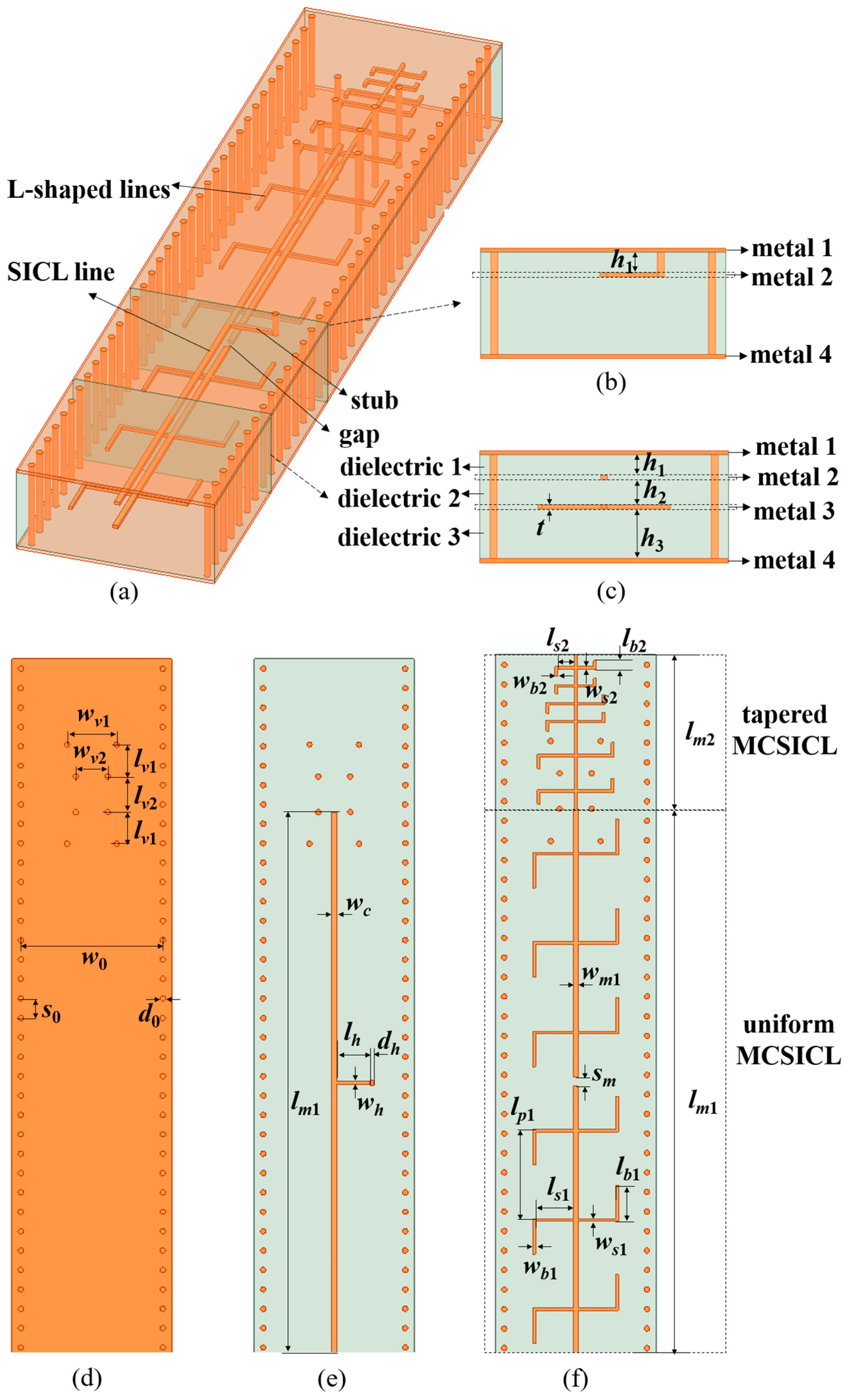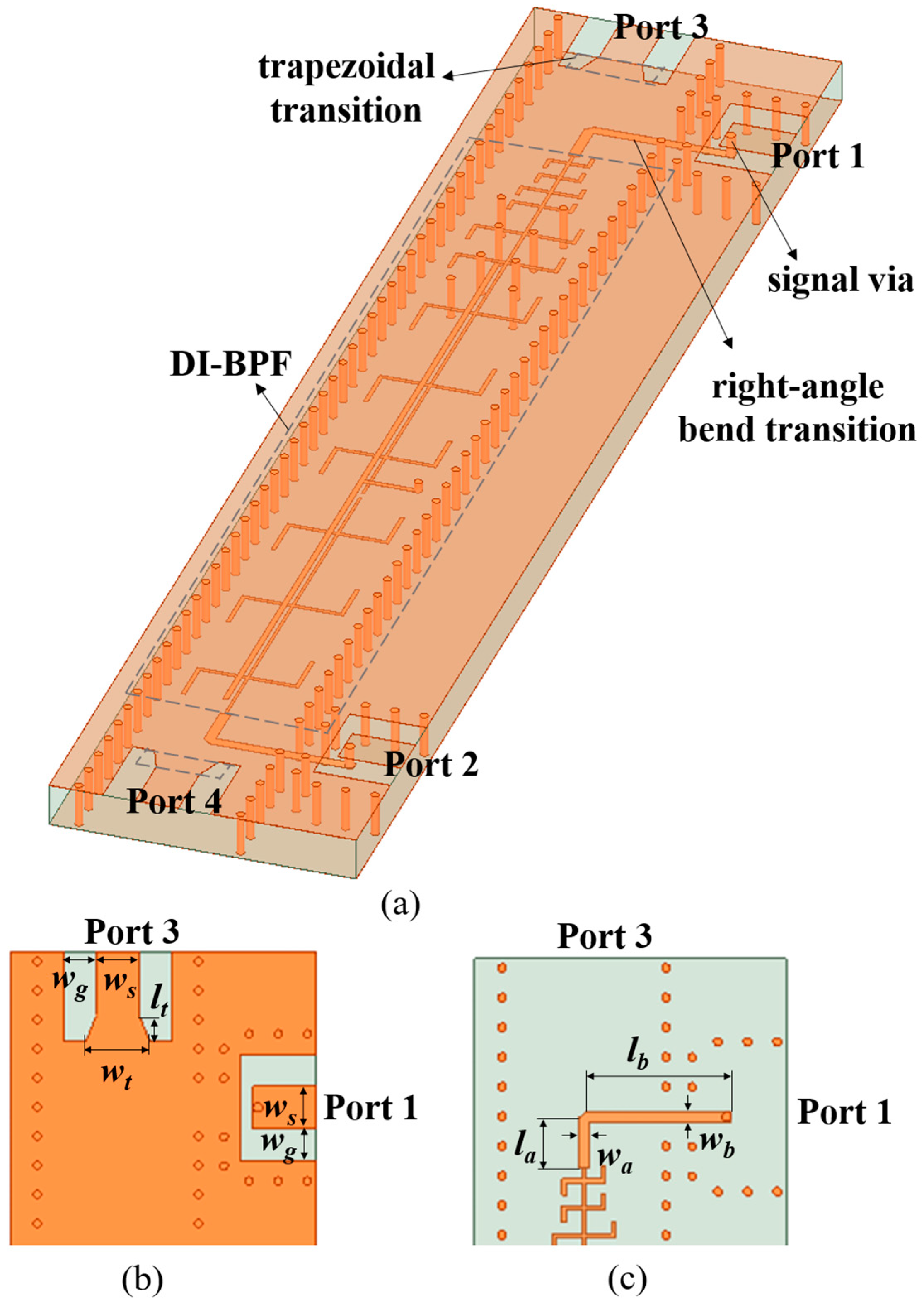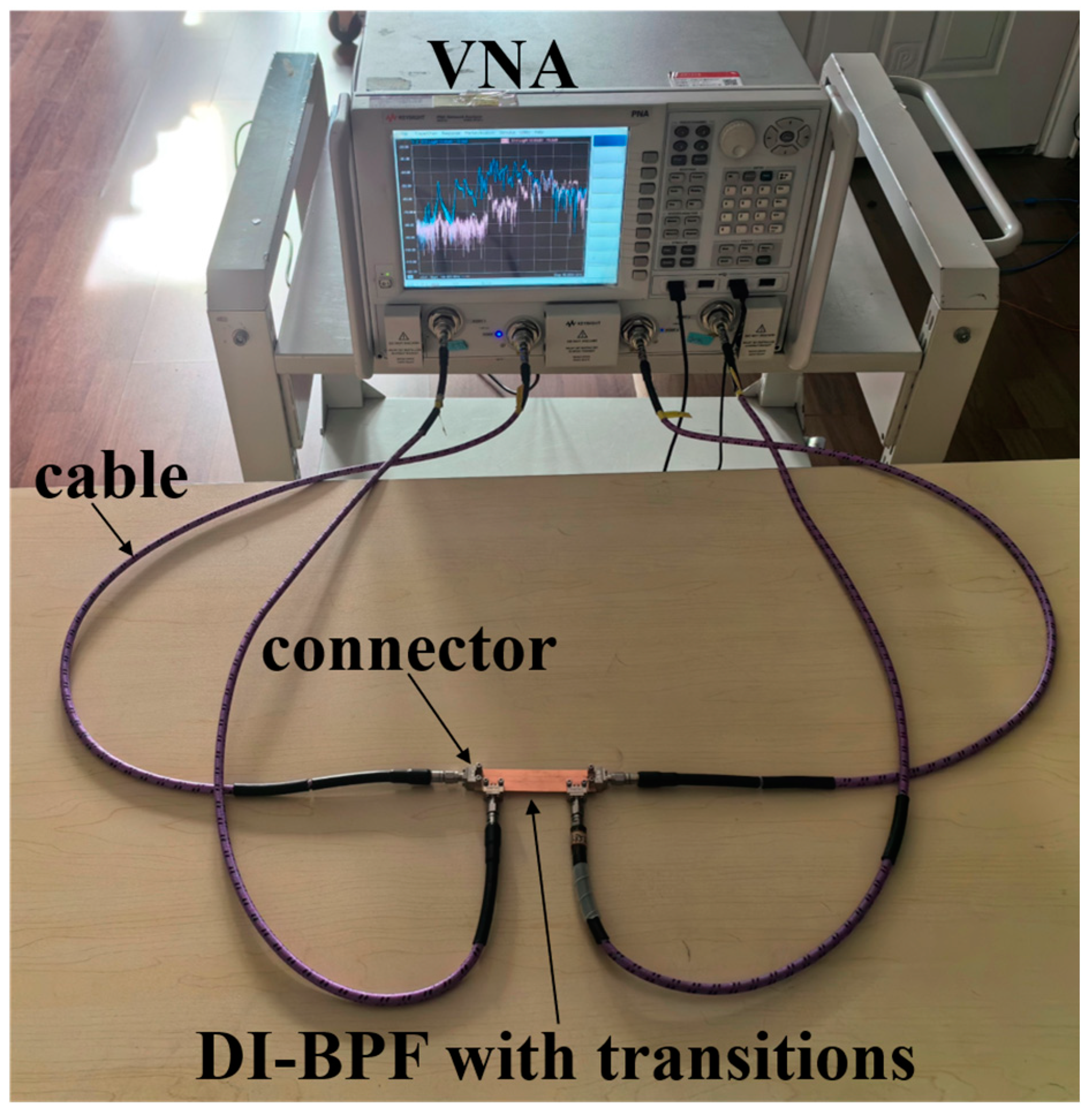A Large Frequency Ratio Dual-Band Integrated Bandpass Filter Based on MCSICL Structure
Abstract
:1. Introduction
2. Structures of the Proposed DI-BPF
2.1. The Proposed DI-BPF
2.2. The Transition Structure
3. Design Principle of the Proposed DI-BPF
3.1. Low-Frequency Bandpass Filter
3.2. High-Frequency Bandpass Filter
4. Experimental Results and Discussion
4.1. Design and Fabrication
4.2. Verification of the Equivalent Circuit Models
4.3. Experimental Setup
4.4. Simulation and Measurement Results
4.5. Comparisons
5. Conclusions
Author Contributions
Funding
Data Availability Statement
Conflicts of Interest
References
- Loung, V.Y.K.; Ngah, R.; Owusu, J.; Han, C.T.; Koduah, S.T.; Din, J. Key technologies and future trends of 5G wireless network applications. In Proceedings of the IEEE 6th International Conference Signal Image Process (ICSIP), Nanjing, China, 22–24 October 2021; pp. 908–914. [Google Scholar]
- Rappaport, T.S.; Sun, S.; Mayzus, R.; Zhao, H.; Azar, Y.; Wang, K.; Wong, G.N.; Schulz, J.K.; Samimi, M.; Gutierrez, F. Millimeter wave mobile communication for 5G cellular: It will work! IEEE Access 2013, 1, 335–349. [Google Scholar] [CrossRef]
- Tang, W.S.; Zheng, S.Y.; Pan, Y.M.; Liu, H.W. A Frequency independently tunable dual-band bandpass filter with large frequency ratio and ultra-wide stopband. IEEE Trans. Ind. Electron. 2023, 70, 1894–1904. [Google Scholar] [CrossRef]
- Pang, X.D.; Hong, W.; Yang, T.Y.; Li, L.S. Design and implementation of an active multibeam antenna system with 64 RF channels and 256 antenna elements for massive MIMO application in 5G wireless communications. China Commun. 2014, 11, 16–23. [Google Scholar]
- Bhat, Z.A.; Sheikh, J.A.; Khan, S.D.; Bashir, I.; Parah, S.A. A new method of isolation enhancement of dual-band bandpass filter using composite mode coplanar waveguide structure for 5G and body centric applications. Iran. J. Sci. Technol. Trans. Electr. Eng. 2022, 47, 317–326. [Google Scholar] [CrossRef]
- Xu, J.X.; Zhang, X.Y.; Li, H.Y.; Yang, Y.; Dutkiewicz, E.; Xue, Q. Ultracompact multichannel bandpass filter based on trimode dielectric-loaded cavities. IEEE Trans. Microw. Theory Technol. 2020, 68, 1668–1677. [Google Scholar] [CrossRef]
- Chaudhury, S.S.; Awasthi, S.; Singh, R.K. Dual-band bandpass filter based on substrate integrated waveguide loaded with mushroom resonators. Microw. Opt. Technol. Lett. 2020, 62, 2226–2235. [Google Scholar] [CrossRef]
- Krishna, I.S.; Mukherjee, S. Fully shielded and self-packaged compact quarter-mode substrate integrated coaxial line bandpass filter for X and K-band. Int. J. RF Microw. Comput. Aided Eng. 2022, 32, e23529. [Google Scholar] [CrossRef]
- Liang, G.Z.; Chen, F.C. A compact dual-wideband bandpass filter based on open-/short-circuited stubs. IEEE Access 2020, 8, 20488–20492. [Google Scholar] [CrossRef]
- Wang, X.D.; Wang, J.P.; Zhu, L.; Choi, W.W.; Wu, W. Compact stripline dual-band bandpass filters with controllable frequency ratio and high selectivity based on self-coupled resonator. IEEE Trans. Microw. Theory Technol. 2020, 68, 102–110. [Google Scholar] [CrossRef]
- Xu, J.X.; Zhang, X.Y. Dual-channel dielectric resonator filter and its application to Doherty power amplifier for 5G Massive MIMI system. IEEE Trans. Microw. Theory Technol. 2018, 66, 3297–3305. [Google Scholar] [CrossRef]
- Xu, L.; Yu, W.; Chen, J.X. Design of dual-channel filter based on dual-mode dielectric resonators. IEEE Trans. Circuits Syst. Ⅱ Exp. Briefs. 2022, 69, 45–49. [Google Scholar] [CrossRef]
- Xu, J.X.; Huang, M.; Song, S.L.; Li, H.Y. Compact multichannel filters and multiplexers based on dual-coaxial resonators. IEEE Trans. Circuits Syst. Ⅱ Exp. Briefs. 2022, 69, 4664–4668. [Google Scholar] [CrossRef]
- Su, Y.H.; Lin, X.Q.; Yu, J.W.; Fan, Y. Mode composite coplanar waveguide. IEEE Access 2019, 7, 109278–109288. [Google Scholar] [CrossRef]
- Yang, S.L.; Xu, J.; Yu, Z.Q.; Zhou, J.Y.; Hong, W. A structure reuse method for realizing large frequency ratio dual-band multi-channel integrated filters. IEEE Trans. Circuits Syst. Ⅱ Exp. Briefs. 2022, 69, 2101–2105. [Google Scholar] [CrossRef]
- Li, Y.J.; Wang, J.H. Dual-band leaky-wave antenna based on dual-mode composite microstrip line for microwave and millimeter-wave applications. IEEE Trans. Antennas Propag. 2018, 66, 1660–1668. [Google Scholar] [CrossRef]
- Su, Y.H.; Lin, X.Q.; Fan, Y.; Wu, K. Mode composite sandwich slot line and its applications in antenna development. IEEE Trans. Antennas Propag. 2020, 68, 4250–4258. [Google Scholar] [CrossRef]
- Zhu, Y.; Li, X.C.; Mao, J.F. Mode composite substrate integrated coaxial line based on substrate integrated coaxial line and L-shaped SSPP structure. IEEE Trans. Compon. Packag. Manuf. Technol. 2023, 13, 528–536. [Google Scholar] [CrossRef]
- Su, Y.H.; Fan, Y.; Lin, X.Q.; Wu, K. Single-layer mode composite coplanar waveguide dual-band filter with large frequency ratio. IEEE Trans. Microw. Theory Technol. 2020, 68, 2320–2330. [Google Scholar] [CrossRef]









| Para. | Values | Para. | Values | Para. | Values | Para. | Values |
|---|---|---|---|---|---|---|---|
| w0 | 4 | s0 | 0.5 | d0 | 0.2 | t | 0.018 |
| h1 | 0.127 | h2 | 0.127 | h3 | 0.254 | wv1 | 2.15 |
| wv2 | 1.2 | lv1 | 2.05 | lv2 | 2.3 | wc | 0.2 |
| lm1 | 42.1 | lh | 1.75 | wh | 0.12 | dh | 0.2 |
| wm1 | 0.15 | lp1 | 7 | lm2 | 8 | sm | 0.1 |
| ls1 | 1.425 | lb1 | 3.05 | ws1 | 0.15 | wb1 | 0.15 |
| ls2 | 0.425 | lb2 | 0.65 | ws2 | 0.15 | wb2 | 0.15 |
| wa | 0.4 | la | 1.45 | wb | 0.4 | lb | 4.2 |
| ws | 1.6 | wg | 1 | lt | 0.67 | wt | 2.39 |
| Para. | Values | Para. | Values | Para. | Values | Para. | Values |
|---|---|---|---|---|---|---|---|
| θs1 | 5.8° | θb1 | 12.3° | θp1 | 27.5° | θs2 | 1.7° |
| θb2 | 2.6° | θp2 | 4° | θh | 6.66° | Zoe | 173 Ω |
| Zoo | 70.2 Ω | Zh | 110 Ω | Cg | 0.8 fF | Zs1, Zb1 | 94.2 Ω |
| Zs2, Zb2 | 94.2 Ω | Zm1 | 94.2 Ω | K01 | 0.4805 | K12 | 0.1859 |
| K23 | 0.1859 | K34 | 0.4805 | - | - | - | - |
| Ref. | Type | Freq. (GHz) | f2/f1 | IL (dB) | Isolation (dB) | Size (λg × λg) | ||
|---|---|---|---|---|---|---|---|---|
| f1 | f2 | f1 | f2 | |||||
| [7] | SIW | 2.2 | 4.18 | 1.9 | 1 | 1.8 | - | 0.112 |
| [9] | ML | 2.4 | 5.2 | 2.1 | 0.3 | 0.7 | - | 0.056 |
| [11] | RW | 3.525 | 3.525 | 1 | 0.32 | 0.32 | 25.3 | 0.176 |
| [12] | RW | 1.53 | 1.68 | 1.1 | 0.68 | 0.68 | 24.5 | 0.084 |
| [13] | RW | 2.81 | 3.32 | 1.18 | 0.32 | 0.41 | 80 | 0.054 |
| [15] | MCTL | 4.2 | 28 | 6.67 | 0.6 | 2.7 | 54 | 0.508 |
| [19] | MCCPW | 1.65 | 35 | 21.1 | 0.6 | 1.8 | 28 | 0.052 |
| This Work | MCSICL | 1.9 | 44 | 23.16 | 1.3 | 1.9 | 30 | 0.019 |
Disclaimer/Publisher’s Note: The statements, opinions and data contained in all publications are solely those of the individual author(s) and contributor(s) and not of MDPI and/or the editor(s). MDPI and/or the editor(s) disclaim responsibility for any injury to people or property resulting from any ideas, methods, instructions or products referred to in the content. |
© 2024 by the authors. Licensee MDPI, Basel, Switzerland. This article is an open access article distributed under the terms and conditions of the Creative Commons Attribution (CC BY) license (https://creativecommons.org/licenses/by/4.0/).
Share and Cite
Zhu, Y.; Li, X. A Large Frequency Ratio Dual-Band Integrated Bandpass Filter Based on MCSICL Structure. Electronics 2024, 13, 754. https://doi.org/10.3390/electronics13040754
Zhu Y, Li X. A Large Frequency Ratio Dual-Band Integrated Bandpass Filter Based on MCSICL Structure. Electronics. 2024; 13(4):754. https://doi.org/10.3390/electronics13040754
Chicago/Turabian StyleZhu, Yu, and Xiaochun Li. 2024. "A Large Frequency Ratio Dual-Band Integrated Bandpass Filter Based on MCSICL Structure" Electronics 13, no. 4: 754. https://doi.org/10.3390/electronics13040754





